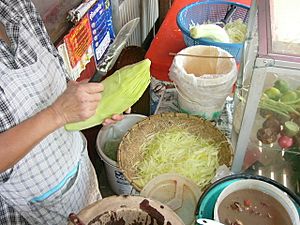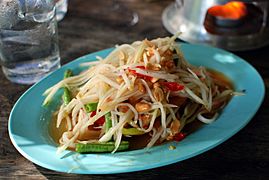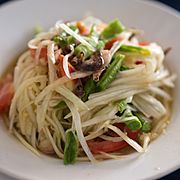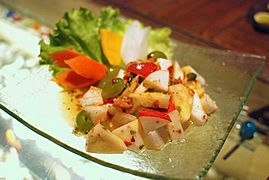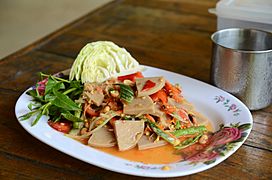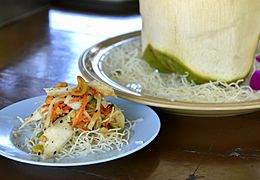Green papaya salad facts for kids
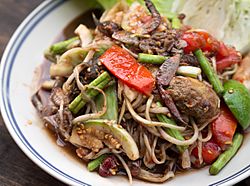
Green papaya salad with yardlong beans, chili, pla ra, brined crab, hog plum and lime
|
|
| Type | Salad |
|---|---|
| Place of origin | Laos, Northeastern Thailand |
| Region or state | Southeastern Asia |
| Associated national cuisine | Burmese, Cambodian, Lao, Thai, Vietnamese |
| Main ingredients | Green papaya |
Green papaya salad is a super popular and spicy salad. It's made from unripe green papaya that's shredded. People in many Southeast Asian countries love it, like Cambodia, Laos, Myanmar, Thailand, and Vietnam. It's even a national dish in Laos and Thailand! Some people think it was first made by the Lao people. This yummy dish was even called one of the World's 50 most delicious foods by CNN.
Contents
History of Green Papaya Salad
Did you know that papayas and chili peppers are not originally from Asia? They were brought to Southeast Asia in the 1600s. Spanish and Portuguese explorers brought them from the Americas. We don't know exactly when papayas arrived in Laos. But by 1836, they were already a big part of Lao culture.
A Thai historian named Sujit Wongthes has an idea about how this salad started. He thinks it began with Chinese-Lao people living in Central Thailand. They took an old Lao tradition of making fruit salads, called tam som. Then they started making salads with papayas. This new dish became known as som tam around the late 1700s or early 1800s.
The salad, along with papayas, spread to Northeast Thailand. This happened when a railway line was built in the late 1800s and early 1900s. The dish became even more popular after 1957. That's when Mittraphap Road opened, bringing new types of papayas. Since then, it has become very popular with Lao people in both Isan (Northeast Thailand) and Laos. The spicy flavor also spread from Central Thailand, where chili peppers arrived first.
However, chili peppers were already common in Laos by 1861. A French explorer, Henri Mouhot, saw them being used in traditional Lao cooking. In the 1950s and 1960s, green papaya salad was not well-known in Bangkok. You could only find it near boxing stadiums or at food carts where workers from Northeast Thailand ate. Later, when Thai national cuisine was being standardized, green papaya salad was included. It was changed a bit, with less chili and more sugar. Today, green papaya salad is a national dish in both Laos and Thailand.
How to Make Green Papaya Salad
This salad is special because it brings together five main tastes. You get sourness from lime, spiciness from chili, and saltiness from fish sauce. There's also a savory taste from the fish sauce, and sweetness from palm sugar. All the ingredients are mixed and pounded together. This is done in a mortar with a pestle. The names for the dish in Khmer, Lao, and Thai actually mean "pounded papaya."
In Laos, green papaya salad is a very important traditional food. In Laos, all pounded salads are called tam som. This can include salads made with or without green papaya. But if someone just says tam som, they usually mean green papaya salad. To be super clear, people might say tam maak hoong, which means "pounded papaya."
In Thailand, you can usually tell the person making the salad how you like it. If you want the original style from Laos or Isan, you can ask for som tam Lao. The version made in central Thailand is called som tam Thai.
Traditionally, green papaya salad sold on the streets of Bangkok was very spicy. It had a lot of hot bird's eye chili. But now, because many tourists enjoy it, it's often made less spicy.
What's in Green Papaya Salad?
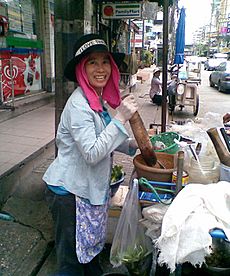
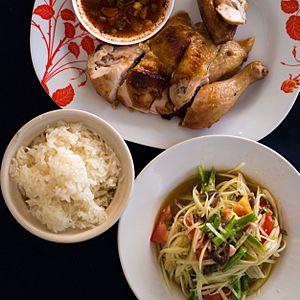
Besides papaya, many other ingredients are added and pounded in the mortar. Here are some common ones:
- Asparagus beans (also called yardlong beans)
- Brined "rice field crabs" (small freshwater crabs)
- Chili peppers
- Dried shrimp
- Fish sauce
- Garlic
- Monosodium glutamate (a flavor enhancer)
- Hog plums
- Lime slices and lime juice
- Palm sugar
- Shrimp paste
- Fish paste
- Raw Thai eggplant
- Small cherry or grape tomatoes
Green papaya salad is often eaten with glutinous rice (sticky rice) and kai yang (grilled chicken). You can also eat it with fresh rice noodles. Or you can enjoy it as a snack by itself, maybe with crispy pork rinds. People often serve it with raw green vegetables. These include water spinach and white cabbage wedges. These veggies help cool down the spiciness!
Different Kinds of Green Papaya Salad
Green papaya salad is thought to have started in Laos. From there, it spread to Cambodia, Thailand, and Vietnam. You can find different versions of this dish all over Thailand, Cambodia, and Vietnam. In Western countries, it's usually known by its Thai name, som tam.
There's also a version of green papaya salad that isn't spicy. This one is much sweeter. It often has crushed peanuts and usually doesn't have fish paste or brined crab. In Central Thailand, this version uses dried brine shrimp.
Instead of papaya, other fruits or vegetables can be used as the main ingredient. Here are some popular variations in Laos and Thailand:
- Cucumber salad (tam maak taeng)
- Green and unripe mango salad (tam maak muang)
- Green and unripe banana salad (tam maak kuai)
- Hard and unripe santol salad (tam krathon)
- Banana flower salad (tam hua pli)
- Malay gooseberry salad (tam mayom)
- Pomelo salad (tam som o)
- Mu yo sausage salad (tam mu yo)
- Mixed fruit salad (tam phonlamai ruam)
- Tam Thaad: This is a papaya salad served on a big tray. It has many ingredients all together. This makes it easy to share and enjoy in a group.
Gallery
-
Green papaya salad with banana flowers (tam hua pli)
-
Green papaya salad with mu yo sausage (tam mu yo)
-
A variation of the salad with green mango instead of papaya and dried anchovies (tam mamuang pla haeng thot)


